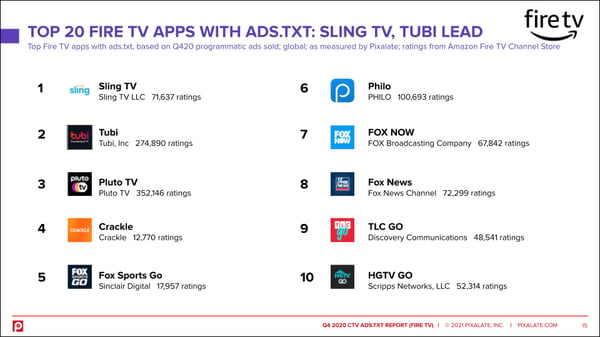
Pixalate recently released the industry’s first Connected TV App-Ads.txt Reports for Roku Apps and Amazon Fire TV Apps, reviewing app-ads.txt adoption trends in 2020.
The reports analyze the state of app-ads.txt adoption among Connected TV (CTV) apps in the Roku and Amazon Fire TV Channel Stores (“Roku apps” and “Fire TV apps”) in 2020.
This blog details the top 10 Amazon Fire TV apps* that have app-ads.txt files, as of Q4 2020.

The full report contains the top 20 Roku apps* with app-ads.txt as of Q4 2020.
*Note: “Top apps” are based on the number of programmatic ads sold, net of invalid traffic (IVT), as measured by Pixalate.
What's inside the reports
Pixalate's 2020 Connected TV App-Ads.txt Reports for Roku Apps and Amazon Fire TV Apps include:
Download free copies of the reports here: Roku App-Ads.txt Trends in 2020 and Amazon Fire TV App-Ads.txt Trends in 2020.
The content of this blog, and the Q4 2020 CTV App-Ads.txt Reports (the “Report(s)”), reflect Pixalate’s opinions with respect to factors that Pixalate believes can be useful to the digital media industry. The data has not been audited or reviewed by a third party, but the research and insights are grounded in Pixalate’s proprietary technology and analytics, which Pixalate is continuously evaluating and updating. Any references to outside sources in the Reports and herein should not be construed as endorsements. Pixalate’s opinions are just that – opinions – which means that they are neither facts nor guarantees. Pixalate is sharing this data not to impugn the standing or reputation of any entity, person or app, but, instead, to report findings and trends pertaining to apps available on the Roku and Amazon Fire TV channel stores and the inventory supply partners of such apps, derived from each app’s app-ads.txt file. Pixalate does not independently verify third-party information (e.g. whether the information specified in app-ads.txt files is complete, current and accurate).
*By entering your email address and clicking Subscribe, you are agreeing to our Terms of Use and Privacy Policy.
These Stories on Privacy
*By entering your email address and clicking Subscribe, you are agreeing to our Terms of Use and Privacy Policy.

Disclaimer: The content of this page reflects Pixalate’s opinions with respect to the factors that Pixalate believes can be useful to the digital media industry. Any proprietary data shared is grounded in Pixalate’s proprietary technology and analytics, which Pixalate is continuously evaluating and updating. Any references to outside sources should not be construed as endorsements. Pixalate’s opinions are just that - opinion, not facts or guarantees.
Per the MRC, “'Fraud' is not intended to represent fraud as defined in various laws, statutes and ordinances or as conventionally used in U.S. Court or other legal proceedings, but rather a custom definition strictly for advertising measurement purposes. Also per the MRC, “‘Invalid Traffic’ is defined generally as traffic that does not meet certain ad serving quality or completeness criteria, or otherwise does not represent legitimate ad traffic that should be included in measurement counts. Among the reasons why ad traffic may be deemed invalid is it is a result of non-human traffic (spiders, bots, etc.), or activity designed to produce fraudulent traffic.”

